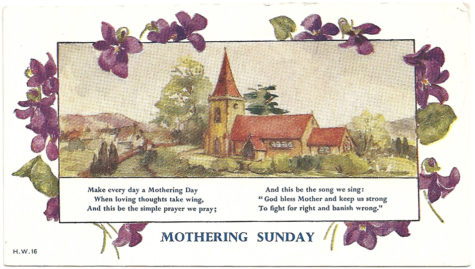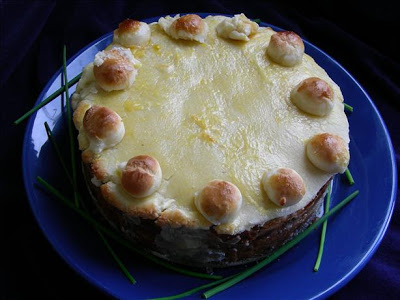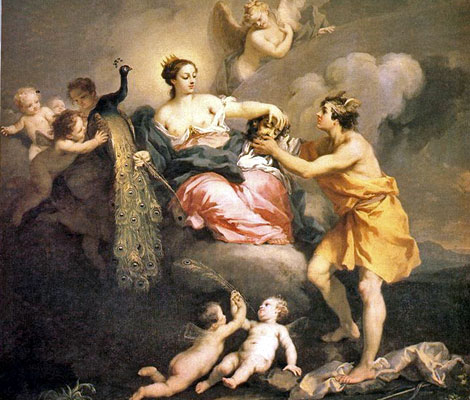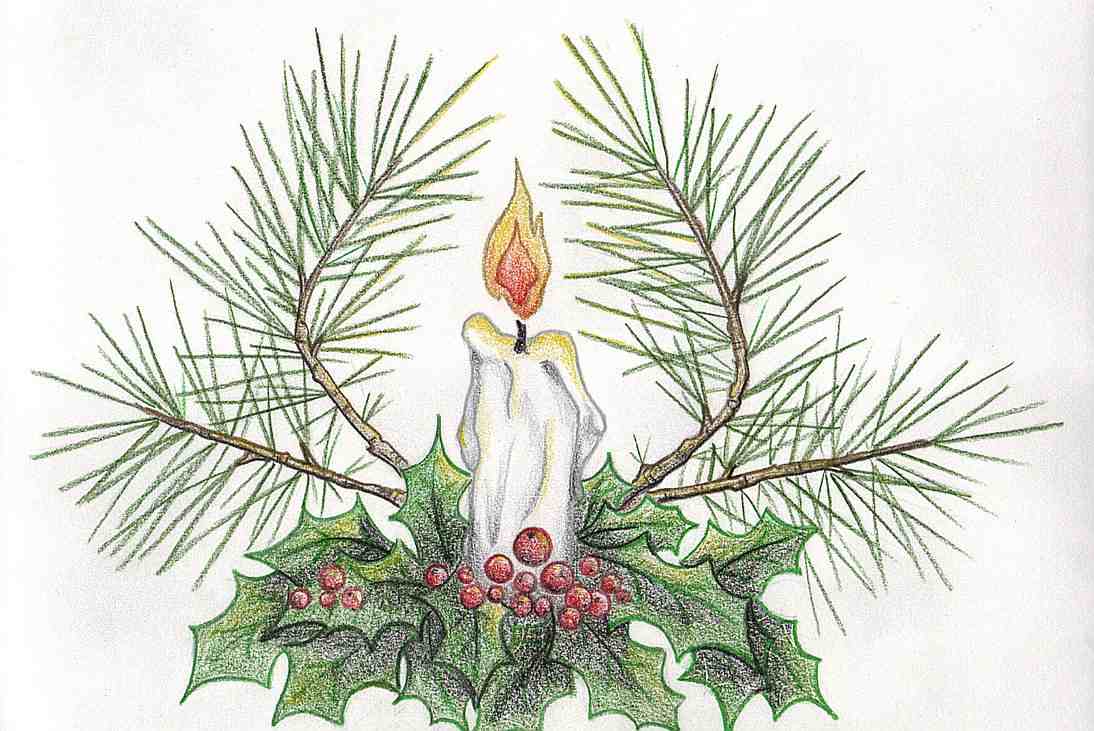Mothers
Mothering Sunday has been celebrated on the fourth Sunday of Lent since the 16th century. In Bristol, Mothering Sunday was commemorated with Mothering Buns as well as cakes.
A Mothering Bun is a circular, slightly enriched, bread bun with white sugar icing strewn with hundreds-and-thousands. These small, fairly plain yeast rolls were also topped with the much-appreciated caraway or aniseed comfits (candies) that also flavored bath buns and seed cake.
From The Verse-Book of a Homely Woman:
Then down to Farmer Westacott’s, there’s doings fine and grand,
Because young Jake is coming home from sea, you understand.
Put into port but yesternight, and when he steps ashore,
‘Tis coming home the laddie is, to Somerset once more.
And so her’s baking spicy cakes, and stirring raisins in,
To welcome of her only chick, who’s coming Mothering.
Here’s a recipe:
A specialty of Bristol, these are made by local bakers the day before Mothering Sunday. Traditionally, on this day only, the Lent fast was relaxed. The buns used to be decorated with caraway or aniseed; today, hundreds and thousands are used.
Ingredients for the buns:
- 500g strong white bread flour
- 1 tsp salt
- 50g caster sugar
- 7g sachet instant yeast
- 50g unsalted butter, diced and softened
- 300ml water
Ingredients for the icing:
- 200g icing sugar
- 2–3 tbsp water
Instructions:
Put the flour in a large bowl. Add the salt and sugar on one side, the yeast on the other. Add the butter and three-quarters of the water, then turn the mixture round with the fingers of one hand. Add the remaining water a little at a time, mixing until you have taken in all the flour and the dough is soft and slightly sticky; you might not need all the water.
Oil the work surface to stop the dough sticking. Turn out the dough and knead for 5 mins, or until smooth and no longer sticky. Lightly oil the bowl, return the dough to it and cover with cling film. Leave to rise for at least an hour, until doubled in size. Line 2 baking trays
with baking parchment.
Scrape the dough out of the bowl onto a lightly floured surface and fold it inwards repeatedly until all the air has been knocked out and the dough is smooth. Divide into 12 pieces.
Roll each piece into a ball by placing it into a cage formed by your hand on the work surface and moving your hand in a circular motion, rotating the ball rapidly.
Put the balls of dough on the prepared baking trays, spacing them slightly apart. (They should just touch each other when they have risen.) Place each tray in a clean plastic bag and leave to prove for about 40 mins, until the rolls have doubled in size. Heat the oven to 220C/Fan 200/425F.
Bake for 10–12 mins, until the rolls are golden and sound hollow when tapped underneath. Transfer to a wire rack to cool.
For the icing, mix the icing sugar with enough water to give a thick but pour-able consistency. Dip each roll into the icing and then into the hundreds and thousands. Makes 12 buns.
Sources: Foods of England and Simple Things
Mothering Sunday is a holiday celebrated by Catholic and Protestant Christians in some parts of Europe. It falls on the fourth Sunday in Lent, exactly three weeks before Easter.
The other names attributed to the fourth Sunday in Lent include:
- Refreshment Sunday
- Pudding Pie Sunday (in Surrey, England)
- Mid-Lent Sunday
- Simnel Sunday
- Rose Sunday
Simnel Sunday is named after the practice of baking simnel cakes to celebrate the reuniting of families during the austerity of Lent. (Here is a recipe: Simnel Cake.) Because there is traditionally a relaxation of Lenten vows on this particular Sunday in celebration of the fellowship of family and church, the name Refreshment Sunday is sometimes used, although rarely today.
Simnel cake is a traditional confection associated with both Mothering Sunday and Easter. Around 1600, when the celebration was only held in England and Scotland, a different kind of pastry was preferred. In England, “Mothering Buns” or “Mothering Sunday Buns” were made to celebrate. These sweet buns are topped with pink or white icing and the multi-colored sprinkles known as “hundreds and thousands” in the UK. (Here’s a recipe: Mothering Buns). They are not widely made or served today in the UK but in Australia they are a bakery staple, not related to any particular celebration. In Northern England and Scotland some preferred “Carlings”, pancakes made of steeped peas fried in butter.
It is sometimes said that Mothering Sunday was once observed as a day on which people would visit their “mother” church. During the 16th century, people returned to their mother church, the main church or cathedral of the area, for a service to be held on Laetare Sunday. This was either the church where they were baptized, or the local parish church, or more often the nearest cathedral.
Anyone who did this was commonly said to have gone “a-mothering”, although whether this term preceded the observance of Mothering Sunday is unclear. In later times, Mothering Sunday became a day when domestic servants were given a day off to visit their mother church, usually with their own mothers and other family members. The children would pick wild flowers along the way to place in the church or give to their mothers. Eventually, the religious tradition evolved into the Mothering Sunday secular tradition of giving gifts to mothers.
It was often the only time that whole families could gather together, since on other days they were prevented by conflicting working hours, and servants were not given free days on other occasions.
Whatever its origins, it is now an occasion for honoring the mothers of children and giving them presents. It is increasingly being called Mothers’ Day, although that has always been a secular event quite different from the original Mothering Sunday. In the UK and Ireland, Mothering Sunday is celebrated in the same way as Mothers’ Day is celebrated elsewhere.
By the 1920’s the custom of keeping Mothering Sunday had tended to lapse in Ireland and in continental Europe. In 1914, inspired by Anna Jarvis’s efforts in the United States, Constance Penswick-Smith created the Mothering Sunday Movement, and in 1921 she wrote a book asking for the revival of the festival.
Its wide scale revival was through the influence of American and Canadian soldiers serving abroad during World War II; the traditions of Mothering Sunday, still practiced by the Church of England and Church of Ireland were merged with the newly imported traditions and celebrated in the wider Catholic and secular society. UK-based merchants saw the commercial opportunity in the holiday and relentlessly promoted it in the UK; by the 1950’s, it was celebrated across all the UK.
People from Ireland and the UK started celebrating Mothers’ Day on the same day that Mothering Sunday was celebrated, the fourth Sunday in Lent. The two celebrations have now been mixed up, and many people think that they are the same thing.
Mothering Sunday remains in the calendar of some Canadian Anglican churches, particularly those with strong English connections.
Found at: Wikipedia
A wonderful spiced and fruited cake which heralds the advent of Spring, simnel cake has a fascinating cultural heritage with roots that stretch back to the Romans and Athenians. In Britain, known as the Shrewsbury Simnel, it is simply made using white flour, fragrant spices and is generously studded with dried fruits and pungent peel.
Like a Christmas cake, it is covered with pale sweet almond paste. The decoration is plain – twelve little balls of smooth paste. A specially baked simnel cake is a wonderful gift to take to your mother for Matronalia, Mother’s Day, or Mothering Sunday Tea Time. Decorate it with crystalised flowers and tie some yellow ribbon around the side.
Ingredients:
For the almond paste:
- 400 g icing sugar, sifted
- 250 g ground almonds
- 1 large egg yolk, beaten lightly
- 3-4 tablespoons orange juice
- 5 drops almond essence
For the cake :
- 250 g plain flour
- 1 pinch salt
- 1 teaspoon nutmeg
- 1 teaspoon cinnamon
- 280 g currants
- 250 g sultanas
- 110 g mixed peel
- 160 g butter
- 160 g caster sugar
- 3 large eggs
- 200 ml milk, to mix
You will also need:
- a sifter,
- nest of bowls,
- food processor or electric beater,
- spatula,
- wooden spoon,
- 24 cm round cake tin,
- baking paper,
- brown paper and twine,
- rolling pin,
- thin metal skewer.
To make your own almond paste you will need:
- a food processor fitted with a steel blade.
- Don’t be tempted to use store-bought almond paste because it contains lots of sugar and few almonds, it will turn to liquid under the grill.
Directions:
Place icing sugar and almonds in food processor bowl. Process, slowly dripping in egg yolk, orange juice and almond essence. The mixture should form a pliable paste. Set aside a small portion for balls with which to decorate the cake. Roll out the remaining paste into 2 circles which are the approximate size of the tin. Set aside.
Preheat oven to 160°C/320°F.
Use a sturdy non-stick cake tub or line the buttered base with baking paper. As the baking period is long (1-1 1/2 hours), prevent the cake drying out by wrapping a double thickness of brown paper around the pan and securing it with twine.
Sift flour, salt and spices together, then stir in fruit and peel. Cream butter and sugar thoroughly until light and creamy then beat in eggs one at a time, until the mixture is fluffy. (Reserve a drop of egg yolk for brushing over top layer of almond paste.). Stir flour and fruit into creamed mixture (you may need to add a little milk to give the mixture a dropping consistency).
Place half the mixture into a greased and lined cake tin. Place one pre-rolled round of almond paste over the top. Cover with remaining cake mixture. Before baking the cake, give the pan of mixture a sharp tap on to a firm surface. This settles the mixture and prevents holes from forming in the cake.
Bake in the center of the oven for 1-1 1/4 hours or until a thin metal skewer inserted in the center of the cake comes out without a trace of stickiness. Level the cake by placing a weighted plate on top of the cooked cake while it is still hot.
Turn out cake on to a wire rack after leaving it to settle in the cake tin for between 10 and 15 minutes. Peel off paper and leave to cool completely.
Cover the top of the cake with a second round of almond paste. Roll 12 small balls of paste and place evenly around the top of the cake. Brush the top with a little beaten egg and very lightly brown under the grill until the almond paste turns light golden brown. Remove and leave to cool.
Note from someone who tried this recipe:
I did give the pan it’s tap to get rid of air bubbles but almost had a disaster when I went to take everything off so that I could set this on a cake rack to cool.. the almond paste in the middle was still liquid and was leaking down the sides of the cake at a great rate, so I quickly shoved it as neatly as I could back into the springform and let it cool completely before loosening it again. At least my baking paper helped stem the flow before I lost it all. Some of my twelve little balls slipped off while I had this in the oven the second time… so I’d advise not to put them too near to the edge of the cake.
In ancient Roman religion, the Matronalia (or Matronales Feriae) was a festival celebrating Juno Lucina, the goddess of childbirth (“Juno who brings children into the light”), and of motherhood (mater is “mother” in Latin) and women in general. In the original Roman calendar traditionally thought to have been established by Romulus, it was the first day of the year. As the first day of March (Martius), the month of Mars, it was also the Feriae Martis.
The date of the festival was associated with the dedication of a temple to Juno Lucina on the Esquiline Hill circa 268 BCE, and possibly also a commemoration of the peace between the Romans and the Sabines. On the day, women would participate in rituals at the temple, although the details have not been preserved other than the observation that they wore their hair loose (when Roman decorum otherwise required them to wear it up), and were not allowed to wear belts or to knot their clothing in any place.
At home, women received gifts from their husbands and daughters, and Roman husbands were expected to offer prayers for their wives. Women were also expected to prepare a meal for the household slaves (who were given the day off work), as Roman men did at the Saturnalia.
Patti Wigington at Paganwiccan.about.com wrote this nice little description about Matronalia.
This annual “festival of women” was held in honor of Juno Luciana, a goddess who watched over married women and those in childbirth. This aspect of Juno was associated with childbirth. The name lucina was thought to have come from the Latin word lux (light); thus, when a child was born it was said to have been “brought to light”.
In this aspect the goddess was a lunar deity, often paired with Diana and depicted as holding a torch. In the worship of Juno Lucina, women untied knots and unplaited their hair – sympathetic magic to prevent entanglements in the delivery of babies. She was in charge of newborn infants, and a woman in labor might make offerings to her so that she would have a safe delivery of a healthy child.
Women and girls prayed to her and brought offerings for prosperity in marriage. Gifts were exchanged, people feasted on similla, cakes decorated it with 12 balls of marzipan around the edges. and everyone treated the ladies exceptionally well on this day. Cakes with a similar name, simnel cakes, are associated with Mothering Sunday in England from which Mothers’ Day is derived.
Children of all ages were expected to pay a formal visit to their mothers and to bring a Simnel cake as a gift. In return, the mothers gave their children a special blessing. This custom was so well-established that masters were required to give servants enough time off to visit out-of-town mothers – provided the trip did not exceed 5 days!
Juno was the Roman Mother Goddess, known to the Greeks as Hera, and her original name to the Romans was Junonius. Juno is a counterpart of Janus and the divine watcher over the female sex, so this month is considered the best time to marry. As Juno Moneta, guardian of wealth and money, she had a temple on the Capitoline hill in Rome where the empire’s coins were minted.
Among Juno’s attributes, she is queen of heaven, approximating Frigg in the Northern Tradition, and Mary in the Christian. She is ruler of the high point of year, when there is maximum light and minimum darkness (the northern Summer Solstice).
Later on, Matronalia evolved into Mother’s Day in Europe, and was shifted to the fourth Sunday of Lent. During the Middle Ages, those who had moved away from home would return on this day to their “mother” church, visiting their families who still remained in the village. Servants were allowed to pick flowers from their masters’ gardens, and given the day off to return home; hence, the custom of bringing one’s mother some flowers on Mother’s Day.
In the United States, Mother’s Day actually falls in May, and is held in honor of humanitarian work carried out by women during the Civil War.
 July 9th is the Day of Unn the Wise person. Also known as Aud the Deep-Minded, Unn was a great matriarch who established dynasties in the islands Orcadas, Feroe and Iceland.
July 9th is the Day of Unn the Wise person. Also known as Aud the Deep-Minded, Unn was a great matriarch who established dynasties in the islands Orcadas, Feroe and Iceland.
Example to follow:
Make our own families grow strong, maintain the memory and traditions of our alive ancestors. Remember the great women of your own clan on this Day of Remembrance for Unn the Deep Minded.
About Unn:
Unn was a powerful figure from the Laxdaela Saga who emigrated to Scotland to avoid the hostility of King Harald Finehair. She was the second daughter of Ketill Flatnose, a Norwegian hersir, and Yngvid Ketilsdóttir, daughter of Ketill Wether, a hersir from Ringarike. Unn married Olaf the White (Oleif), son of King Ingjald, who had named himself King of Dublin after going on voyages to Britain and then conquering the shire of Dublin. They had a son named Thorstein the Red
She established dynasties in the Orkney and Faroe Islands by carefully marrying off her grand daughters. Unn then set off for Iceland.
On her ship were twenty men, all of whom were free, but she was still the leader of them, proving that she was respected, but also that she was strong-willed enough to command a ship alone without the help of a man. In addition to the crew, there many other men on her ship, prisoners from Viking raids near and around Britain. They all came from good families, and were called bondsmen. Unn gave these men their freedom once they were in Iceland, making them freed-men, a class between slave and free, where they were not owned, but did not have all the rights of a free man. She also gave them all a great deal of land to farm on and make a living.
As a settler in Iceland she continued to exhibit all those traits which were her hallmark-strong will, a determination to control, dignity, and a noble character. In the last days of her life, she established a mighty line choosing one of her grandsons as her heir. She died during his wedding celebration, presumably accomplishing her goals and working out her destiny in this life. She received a typical Nordic ship burial, surrounded by her treasure and her reputation for great deeds.
Note:
In some pagan calendars this is shown of “Day of Un the Wise Person” which is a misprint.
Source: Asatru.org
May 30 is celebrated as the Feast of the Queen of Heaven. Queen of Heaven, lovely goddess of May, fully grown and gloriously enthroned in pagan and Christian times. May honors the Blessed Virgin Mary, who is the modern-day Queen of Heaven, though somewhat demoted in status from her original divinity.
Have you noticed that it was always Mary who caused the miracles, who appeared to children – as at Lourdes and Fatima? the Queen of Heaven is a hard-working woman, and we light white candles to her. Praise active womanhood wherever you are and all will be well.
Calling upon the Queen of Heaven for aid in times of need is such a universal practice, that I can’t help but think it must be powerful and effective. If you’d like to try it for yourself, here is a prayer to Our Mother of Perpetual Help:
O Mother of Perpetual Help, grant that I may ever invoke Thy most powerful name, which is the safeguard of the living and the salvation of the dying.
O Purest Mary, O Sweetest Mary, let Thy name henceforth be ever on my lips. Delay not, O Blessed Lady, to help me whenever I call on Thee, for, in all my needs:
(name your request for help)
In all my temptations I shall never cease to call on Thee, ever repeating Thy sacred name, Mary, Mary
(again make your request for help).
O what consolation, what sweetness, what confidence, what emotion fills my soul when I pronounce Thy sacred name, or even only think of Thee. I thank God for having given Thee, for my good, so sweet, so powerful, so lovely a name. But I will not be content with merely pronouncing Thy name: let my love for Thee prompt me ever to hail Thee, Mother of Perpetual Help. Amen.
(Now recite nine Hail Marys)
From: The Grandmother of Time and other sources.
May 25 is the Chinese and Japanese Celebration of the Tao – The Mother of the World. In Taoism, a great spiritual tradition of the East, the Goddess is perceived as the mother of the world, the Way to the heart.
On this day, burn incense to the Goddess and meditate on Divine Harmony. The whole philosophy of the Way (or Tao) in Chinese mysticism is essentially a respect for the truth in nature and her ways. It is also a belief that people must live in harmony with the Way and not destroy or interfere but, rather, flow with it. This, as they say, is:
“Holding fast to the Mother. She is the origin of all things and beings, born before heaven and earth. Silent and void she stands alone, does not change, goes round and does not weary, and is capable of being the mother of the world.”
~Tao Teh Ching
From: The Grandmother of Time











